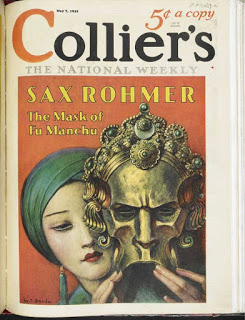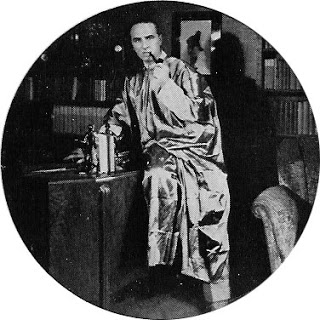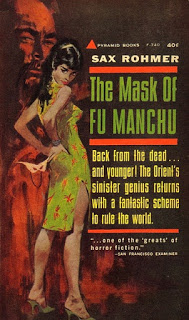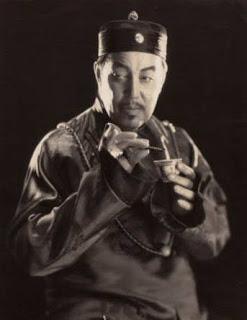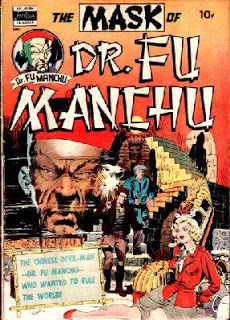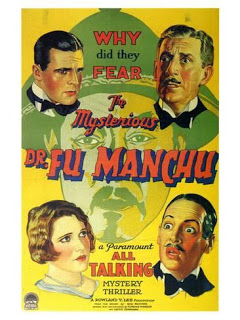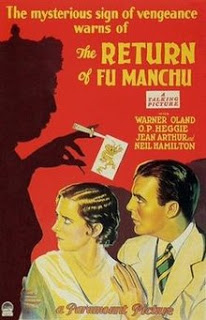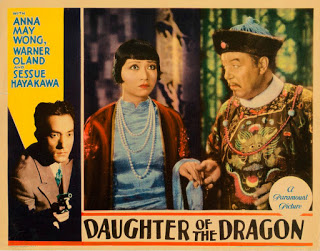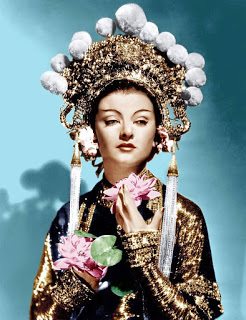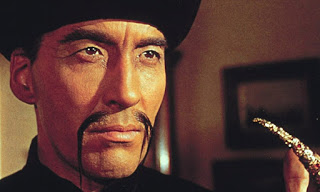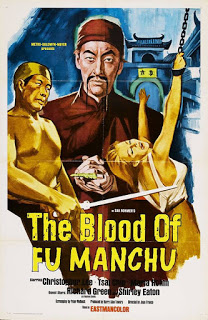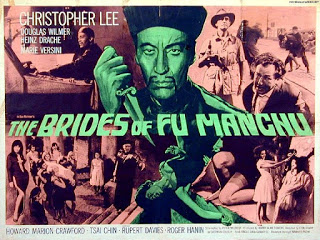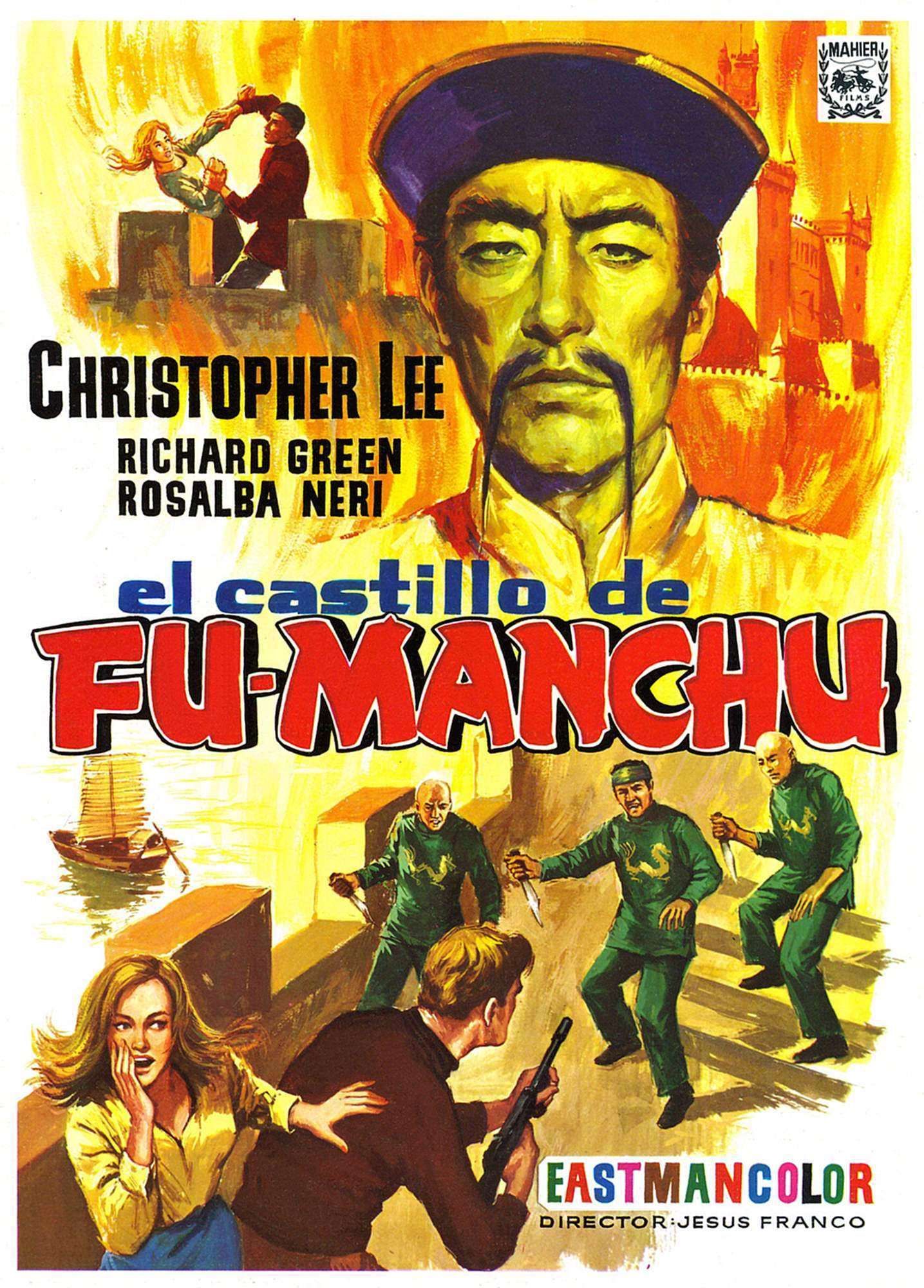Fu Manchu Films
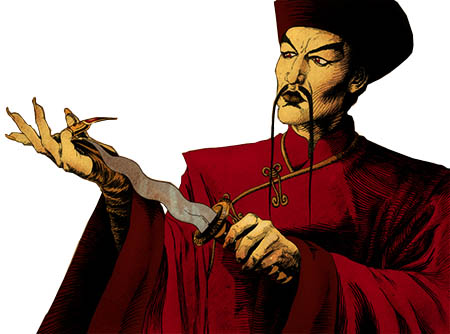
Every now and then I get an impulse to immerse
myself in pulp and nothing is pulpier than the evil incarnate Fu Manchu and
his machinations to take over the world. The character has been around now
for over one hundred years and though it is unlikely that he will be making
appearances any time soon due to the current social taboos, his name is still
one that certainly brings up vivid images in most people.
His first appearance was in a Collier’s Weekly serial starting in 1912 from
the lurid pen of Sax Rohmer. Sax Rohmer (real name Arthur Henry Ward – 1883-1959)
was a journeyman journalist who had been assigned to do a write-up on who
the Big Crime Boss in the Limehouse area of London was. Limehouse was famous
at the time for its seedy nightclubs, low life residents, opium dens, brothels,
crime and poverty back in the early 1900’s. In other words, the good old
days! It was said about Limehouse “thieves all – to a man” and likely the
women as well. Its name derives from the fact that once upon a time lime
kilns were set up to make pottery there. It edges deeply into Chinatown and
was partly the setting of the film Piccadilly with Anna May Wong.
One night while investigating, Rohmer saw an expensive car pull up to a club
and a tall Chinese man get out followed by his minions into the club. This
sparked an idea for his character – that and the fact that a few weeks previously
he and his wife had a session with the Ouija board and the letters spelled
out “Chinaman”. Rohmer was a believer in the occult as was Sir Arthur Conan
Doyle. That was all Rohmer needed. He modeled his story very much on Sherlock
Holmes with the hero being Nayland Smith and his narrator being the good
doctor Petrie and of course Fu Manchu taking the place of Moriarty. The difference
of course was a big one because Fu Manchu was not only an evil criminal genius
he was also intent on taking over the world and destroying the White Man.
Though Rohmer’s intent was no doubt to create a literary villain unlike any
before or really since that has so captured the imagination of the public,
you could also look at Fu Manchu as the antidote to European colonialism
that had subjugated much of Asia and had brought China to a supine position.
In that sense he is a freedom fighter.
Rohmer was both feeding into and reinforcing the prejudices of his day against
the Asians or as was the common term of the day, The Yellow Peril. Today
many fear the Muslims, back then it was the Asian hordes and their crafty
inscrutability. To my surprise I found out that the term was originated by
none other than Kaiser Wilhelm II in 1895 after he had a dream in which the
world was being invaded by Asians with Buddha leading the charge. Clearly,
he had too many sausages and sauerkraut for dinner. This was of course the
same Wilhelm who was a grandson of Queen Victoria and helped militarize Germany
and led it into WWI. So not a great resume really. Of course, the fear and
discrimination against Asians began long before Wilhelm had his dream, most
egregiously in the United States when Chinese came over first during the
gold rush in the 1850’s and after that they worked on the western section
of the Transcontinental Railroad. They were hired because the original workers
quit when the work became too dangerous going over the mountains and also
because of the low wages they were willing to accept.
The Chinese immigration generated a public outcry and fear in California
and there were riots against them with lynchings and various laws passed
to discriminate against them. The main one being the Chinese Exclusion Act
of 1882 which suspended any further immigration by the Chinese and made it
impossible for Chinese immigrants to become U.S. citizens. It was not repealed
until 1943 when we and the Chinese were allies against the Japanese. Horace
Greely famed for his “Go West” advice to America also had this lovely sentiment
“The Chinese are uncivilized, unclean, and filthy beyond all conception without
any of the higher domestic or social relations; lustful and sensual in their
dispositions; every female is a prostitute of the basest order". All this
fear though the Chinese were a tiny percentage of the population. Sound familiar?
Everything new is old again in America. Think about where the descendants
of those original Chinese are likely today – owning businesses, doctors,
lawyers and so on.
A few historical events also lent credence to the West’s fear of Asia. The
Boxer Rebellion that began in 1899 led to the slaughter of many Westerners
in China as well as the 55 day siege in Peking and this was all played up
to huge effect in what was called “Yellow Journalism”. The Boxers were a
cult of Chinese who wanted to rid the country of Western and Christian influence
and thought themselves invulnerable to bullets. They weren’t. The reprisals
against the Chinese – especially from the Germans – was horrific. At the
same time the rise of a militaristic Japan with its successful war against
Russia in 1905 only increased the Yellow Peril dread in the West. It was
the first time an Asian country had defeated a European nation and it sent
some shockwaves through the world. A new power was ascending in the East.
So the Sax Rohmer books and their depiction of a Super Villain Chinese man
intent on destroying the West found a welcoming public. Here is some dialogue
from his first book, The Mystery of Dr. Fu Manchu:
No white man, I honestly believe, appreciates the unemotional cruelty of
the Chinese.
The sinister genius of the Yellow Movement.
The phantom Yellow Peril said Nayland Smith to-day materializes under the
very eyes of the Western world.
And Rohmer describes Fu Manchu as thus – notice there is no mention of the
famous moustache
"Imagine a person, tall, lean and feline, high-shouldered, with a brow like
Shakespeare and a face like Satan, a close-shaven skull, and long, magnetic
eyes of the true cat-green. Invest him with all the cruel cunning of an entire
Eastern race, accumulated in one giant intellect, with all the resources
of science past and present, with all the resources, if you will, of a wealthy
government – which, however, already has denied all knowledge of his existence.
Imagine that awful being, and you have a mental picture of Dr. Fu-Manchu,
the yellow peril incarnate in one man."
The Fu Manchu books were enormously popular and Rohmer wrote three of them
between 1913 and 1916 – then oddly discontinued the series until he took
it up again in 1931, discontinued it during WW2 when the Chinese were our
allies and took it up again in 1948. In total there are 14 Fu Manchu novels.
I have only read the first two and they are in typical fast moving serial
form – something happening all the time, Nayland Smith in and out of danger,
Fu Manchu almost captured but escaping and the loyal Dr. Petrie (named after
Flinders Petrie, the curator of the Egyptian wing of the British museum,
a subject that fascinated Rohmer) always by Nayland’s side. They are not
badly written at all and Rohmer has a very good knack of writing the action
scenes in a breathless and imaginative manner. More so in fact than the films.
As in many of the films that followed, Rohmer began the tradition of Fu Manchu
seemingly dead at the end of the book, only to reappear in the next one.
It should be mentioned that Rohmer wrote a ton of other pulp fiction, but
none of it gained the audience that the Fu Manchu books did. Ironically perhaps,
Rohmer died from the Asiatic Flu in 1959, so the Yellow Peril did him in
after all!
The success of the books of course led to radio, TV, comics and films. Over
twenty Fu Manchu silent shorts were made all starring H. Agar Lyons in a
serial from 1923-1924, an Irishman and thus beginning the tradition of Fu
Manchu being played by a white actor. I don’t know if any of these films
have survived. The first Fu Manchu talkie in which a white actor gets to
do his best Pidgin English (even though the character Fu Manchu in the books
graduated from some of the great universities in the world) was a set of
three films from Paramount beginning in 1929. They all starred Warner Oland
as Dr. Fu Manchu. Oland was originally from Sweden but immigrated to the
U.S. when he was a teenager and began acting in silent films around 1915.
Because of his somewhat Slavic looks he got to play all sorts of ethnic types
and had already portrayed Asians in a few films. After his role as the evil
Chinese man Fu Manchu, Oland was to go on to some fame by portraying the
Good Chinese man, Detective Charlie Chan, in sixteen films until his death
in 1937 from pneumonia after suffering bouts of alcoholism and dementia.
Maybe he played one Chinaman too often.
Film was going through the birth pangs of the transition from silent to talkies
and these three films are very stodgy, earthbound with clunky dialogue and
considerable overacting. In The Mysterious Fu Manchu (1929) the writers took
an unusual angle on Fu Manchu by making him first a good kindly man who goes
insane after his wife and son are killed by the British during the Boxer
Rebellion. He swears vengeance on all the military men he holds responsible
and their offspring to placate his ancestors. At the beginning point of the
film, he has killed nearly all of them through nefarious means and only has
Dr. Petrie and his father to deal with. And Nayland Smith of Scotland Yard
as well. Dr. Petrie is played in the first two films by Neil Hamilton who
was of course to play Commissioner Gordon in the Batman TV show thirty seven
years later. Dr. Petrie’s love interest is a surprising actress, one of my
all-time favorites – Jean Arthur. Her character was kidnapped by Fu Manchu
as a child and been brought up to do his bidding when hypnotized. So far
Arthur had managed to have a miserable career in silent films, playing in
dozens of B Westerns and had a reputation as a terrible actress, which certainly
these first two films only reinforce. She is truly awful. It wasn’t really
until six years later that she struck it big as the wisecracking tough female
reporter in Mr. Deeds Goes to Town. From there her career took off until
she retired after Shane. She was known for being a recluse, refusing publicity
– and called America’s Greta Garbo.
The Return of Fu Manchu (1930) begins right where the first one left off.
It is Fu Manchu’s funeral and Nayland Smith attends because of his respect
for Fu Manchu and for what a friend he was to the “white man” before his
tragedy. Of course, Fu Manchu is not dead and once again plots to kill Dr.
Petrie in as complicated a way as he can. Like all mad geniuses he just can’t
kill him outright. What fun would that be? They kidnap Petrie’s fiancée
(played again by Jean Arthur without a lot of acting improvement) and send
a note to Petrie saying basically – to save her you must come – of course
it is a trap – the Chinese would never bother to save a mere woman but you
white men are weak and I know you will come. Yup.
The third film in the series and the best – The Daughter of the Dragon (1931)
is fascinating only for the two real Asian actors in the film – Anna May
Wong and Sessue Hayakawa. I have written before about Anna May Wong, the
first great Asian actress in Hollywood – born in 1905 in Los Angeles – and
sentenced for most of her acting career to playing stereotypical Chinese
roles as the Dragon Lady or seductive or submissive roles. When the role
of O-Lan in The Good Earth went to Luise Rainer she was crushed. Sessue Hayawaka,
who plays a Chinese detective in the film, was born in Japan, almost committed
seppuku at a young age after disappointing his father and came to the USA
to study at the University of Chicago. That didn’t work out and he drifted
into acting and became a huge star in the Cecile B DeMille film The Cheat
in which he plays romantically opposite a white woman – quite shocking for
the times. He went on to become a silent screen star, but once the talkies
came along his star – like so many others – began to fade but he continued
acting and no doubt some of us know him as Colonel Saito from The Bridge
on the River Kwai (which you can visit in Thailand of course). He is the
hero in this film as Nayland Smith makes no appearance.
This third film pretends that the first two in the series did not exist as
it treads over the same territory and one major character killed in the first
film is back as is Fu Manchu. In The Daughter of the Dragon Anna plays Ling
Moy an “Oriental dancer” of renown who has received word that the father
she has not seen in 20 years is in London and wants to meet her. She is thrilled
only to find out upon seeing him that he is dying and he has a small request.
A favor for dear old dead dad. Kill the rest of the Petrie male line. Being
a good Chinese girl she immediately agrees by saying “The Blood in mine.
The Hate is mine. The Vengeance is Mine”. A promise is a promise. Her plan
is a slow one – no quick death for the son – first she must make him love
her but she says to him “Will my hair ever be blonde? Will my skin ever be
white?” Wong had just returned from her triumphal entrée into the
European film industry and Paramount struck a three picture deal with her.
This was the first one. Now one wonders what is worse – putting an Asian
into a Dragon Lady role or as in the next Fu Manchu film having a Caucasian
play Fu Manchu’s daughter. Wong was to be later harshly criticized by Chinese
for taking these roles to which she replied “that is what was offered to
me”.
In 1932 MGM put out their version of Fu Manchu with The Mask of Fu Manchu
and I thought this was a little gem of a film and is the reason I went on
this Fu Manchu binge. Coming off of his success as the Monster in Frankenstein
in 1931, Boris Karloff was off on his amazing career playing villains, monsters,
ghouls, the criminally insane and in this film Dr. Fu Manchu. As Fu Manchu
he is after the sword of Genghis Khan because this will allow him to dominate
the world and only Nayland Smith stands in his way. Fu Manchu has the aid
of his devious and amoral daughter Fah Lo See, played by a young Myrna Loy
in total camp mode. Loy played all sorts of vamps until she got the role
as Nora in The Thin Man in 1934 and began her reputation as every man's ideal
wife (mine anyway) – she could trade quips and mix martini’s as fast as a
card shark can deal. This perfect wife hit its ideal in the great film –
one of my personal favorites – The Best Years of Our Lives in 1947. Here
she is wonderfully willing to do the bidding of her father to seduce, torture
or kill as any good Chinese daughter will do.
Fu Manchu hit TV as well with a 1956 series of 13 episodes that only lasted
a season and is not all that bad. Nor all that good. It is actually out on
DVD.
The Fu Manchu franchise hit its zenith with the five British-German productions
in the 1960’s starring the legendary Christopher Lee as the diabolical Fu
Manchu (perhaps not co-incidentally during the Vietnam War and rising tensions
with China). A film was released each year from 1965-1969 and they are nearly
all solid films with good production values and enough silliness that at
times slips into campiness to keep you engaged. All the films pretty much
follow the same general plot lines – Fu Manchu has a new plan to conquer
the world – in one a sound wave that can destroy ships, in another a group
of girls who can kiss you to death, in yet another crystals that can freeze
the ocean, poison gas from the air– and only Nayland Smith (played by three
different actors in the series) can stop him. If I had to be a victim, I
would take it by kiss thank you. These two continuously do a dance of seduction
with one another – neither one anything without the other – both incapable
of killing their nemesis in the end because then there would be no challenge
left for them. At the end of each film it appears that Fu Manchu has met
his end but he always rises in time for the next film with the eerie words
“The world has not seen the last of Fu Manchu” ending the film.
Both have their assistants – Smith his loyal Petrie played by Howard Marion-Crawford
in stalwart British upper lip fashion in all five films. This Petrie (as
opposed to the books) is only slightly more competent than Nigel Bruce in
the Basil Rathbone Holmes films. That has always irritated me because clearly
the Watson of the books and Petrie as well are very competent men and certainly
good writers! Not at all the dimwits that film portrays them as. Fu Manchu
has his daughter Lin Tang to do his bidding and his killing. She is played
by Tsai Chin, who had an interesting career. Born in Shanghai she witnessed
both the invasion by Japan and later the Communist takeover. She left China
in 1960 to study acting in England and began receiving small roles – other
than the daughter of Fu Manchu she made appearances in two Bond films - very
far apart – in You Only Live Twice – the assassin – in 1967 and nearly forty
years later as Madam Wu in Casino Royale. But she is perhaps best known as
one of the mothers in Joy Luck Club. She is amazingly still acting and was
recently in the TV series Agents of Shield as May’s mother. Quite a life.
The final two films in the series – The Blood of Fu Manchu and The Castle
of Fu Manchu – were directed by Jess Franco who is much better known for
his Euro-Exploitation films with such fare as Succubus, 99 Women, Venus in
Furs and so on – and on - and on – he is credited with over 200 films as
a director. One might be surprised that Franco would take on two fairly conventional
films but he was always in need of money to make the films he really wanted
to. The Blood of Fu Manchu is definitely spiced up with some nudity, slightly
more graphic violence and even elements of a Spaghetti Western as Fu Manchu
plots from the jungles of South America. But The Castle of Fu Manchu is an
unadulterated mess that is nearly incoherent and often uses stock footage
apparently to save money and even snips out a scene from the Titanic film,
A Night to Remember. It is a rather sad ending for an enjoyable series and
when Fu Manchu pops up at the end when his plans are once again squashed
to announce again that the world has not seen the last of him, you are rather
relieved that in fact it had for the most part. Other than a comedy from
Peter Sellers in 1980 called The Fiendish Plot of Dr. Fu Manchu, we have
heard very little from Fu Manchu and the Yellow Peril. Perhaps time and events
had caught up with him and it certainly would no longer be politically correct
to have a film like this. Maybe we are ready for the next Boogie Man. How
about a diabolically evil Muslim intent on spreading Islam and the dreaded
Sharia Law all over the world? That should sell.


